Interiors of early passenger trains, UK
The interiors of passenger trains in the early 20th century were very different from those of today. This page describes the internal arrangement and décor and provides useful explanatory illustrations. Highlights are firsthand recollections.
____
By the webmaster based on her early recollections with additional research and firsthand contributions
When I was young in 1940s and 1950s Britain, passenger trains were made up of a steam engine at the front, a guard's van at the end and passenger accommodation between. However these trains were more different from modern trains than this description suggests. Read on:
Train coaches and compartments
What are today known as coaches were always known as carriages, which was presumably a hangover from the horse-drawn carriages of Victorian and Edwardian times.
Inside each carriage were a number of smaller compartments, each with a set of two padded bench seats: one facing the engine and the other with its back to the engine. The only exception was inside the dining car. Before the war dining cars were common, but there were none during wartime.
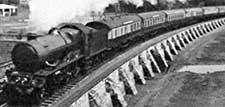
Train showing six or more carriages each containing compartments
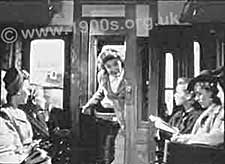
A train compartment with its door to the corridor open
Train corridors
The compartments of trains for long distance travel were connected internally by a narrow corridor. It was along one side - not centrally like in later more open-plan trains. Frequently stopping trains had no corridors.
The corridors were particularly useful for walking along to find a seat on a crowded train and to reach a lavatory at the end of most coaches.
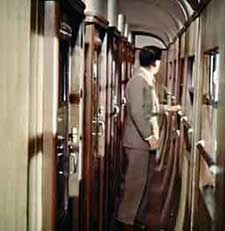
A train corridor
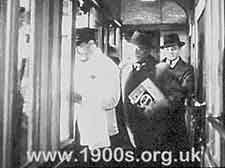
A train corridor, showing how crowded and difficult to move it could become

Train corridor viewed from inside a compartment
Ladies only compartments
Where there was no corridor, it was a sign of the times that my mother would walk along the platform choosing her compartment according to there being no man alone in it. Only a compartment with at least one woman was considered appropriate, and it was best if she was elderly. Apparently there had previously been 'Ladies only' compartments and some may still have been in service, but I don't remember them.
No smoking areas
Smoking was an accepted way of life in the 1940s, so almost all the compartments allowed it and never considered publicising the fact. The only notices about smoking were in a few 'No Smoking' compartments. These compartments were normally at the front and back of a train, but they were patronised by relatively few people because everyone, including non-smokers like my mother, was so used to cigarette smoke that they hardly noticed it.
Chatter among passengers
Before the war, passengers gazed across at each other from their upholstered bench seats, and no one spoke; heads were hidden behind newspapers.
Come the war, we were all one, strangers no more. Talk about air raids, food rationing, battles and films filled the carriage.
Yet, when the war ended this chatter ended too, The reserved English manner returned and people gazed anywhere rather than make eye contact.
Kath O'Sullivan (formerly Margerison)
Luggage racks
Luggage racks were above the passengers' heads, and were corded like hammocks. Being corded, dirt and dust simply fell through them, which must have made cleaning easier - although of course, being fabric, they would hardly ever have been washed.
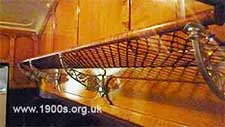
Luggage rack, corded like a hammock*
Luggage racks as hammocks on long journeys
On a wartime train journey from Leeds to Edinburgh in early 1945, the train was packed with troops. I saw men asleep on the luggage racks and asleep on luggage in the corridors. This was by no means unusual.
Kath O'Sullivan (formerly Margerison)
The communication cord - for an emergency stop
In the case of emergency, passengers could stop trains from inside their compartments. There was a chain which passed along the train to ring a bell to alert the driver to stop. It was called the communication cord even though it was a chain, and it was high up, out of the reach of children. I seem to remember from the 1940s and 50s that it was behind a thin pane of glass which passengers had to break to reach it.
In the following photos, the communication cord is called an Alarm. However we always refered to it as a communication cord.
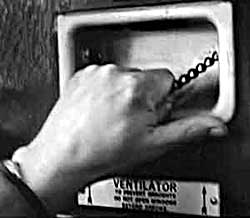
Pulling a communication cord
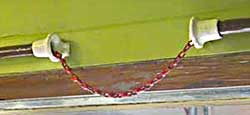
The communication cord of a 1920 or 1930s train**
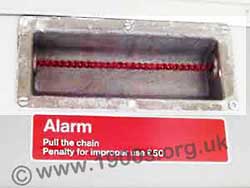
The communication cord of a 1960s train
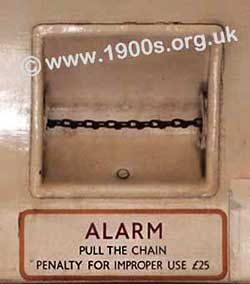
The communication cord of a 1950s train on the
Bluebell Line. Photo courtesy of Les Haines.
Penalty for improper use £25.
On the penalty for misuse of the train communication cord, I recollect that in the 1940s and possibly the earlier part of the 1950s it was £5, presumably with one of those lovely large white fivers that had to be folded to get it into the wallet.
Malcolm Keen
The penalty for improper use was severe. As the photographs show, the penalty was £25 in the 1950s and £50 in the 1960s - which was quite a lot of money then. In the 1940s, the penalty seems to have been £5. In the early trains, passengers appear to have been trusted, as no penalty for improper use was stated.
I never knew of anyone who pulled the communication cord, although it must have happened.
How misuse of the communication cord was prevented
When the train communication cord was pulled, it did not return to being taut when released, so the compartment could be identified after the train stopped. This fact was widely known and prevented misuse.
Douglas Adam
Text and images are copyright
*Photographed by the webmaster with acknowledgements
to York Railway Museum
**Photographed by the webmaster with acknowledgements to Steam Museum, Swindon
***Photographed by the webmaster with acknowledgements to on a Swanage Heritage
train
If you can add anything to this page or provide a photo, I would be pleased if you would contact me.
sources: early 20th century material
sources: ww2 home front and other material
contact
the webmaster/author/researcher/editor
privacy policy

